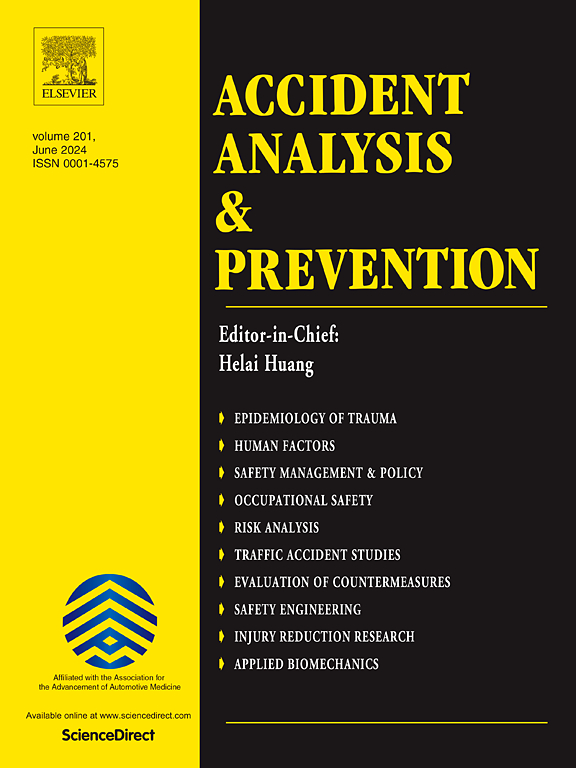感官干扰对反应时间的影响:一种综合建模方法
IF 6.2
1区 工程技术
Q1 ERGONOMICS
引用次数: 0
摘要
听觉干扰会影响驾驶员的注意力、反应和决策能力,从而显著影响驾驶安全,从而增加驾驶员的反应时间。本研究旨在利用维也纳测试系统(VTS)的实验数据来检查这种干扰的影响。来自混合交通环境的80名司机(70%为男性,30%为女性)参与了这项研究,得出了两个年龄组(年轻和成熟)的240个数据样本。在三种情况下评估反应时间:(i)正常,(ii)音乐和(iii)使用VTS呼叫,其中包括需要身体反应的视觉和听觉刺激,从而紧密模拟现实驾驶场景。结果表明,在音乐和呼叫条件下,男性驾驶员的反应时间分别增加了4.8%和20.1%,而女性驾驶员的反应时间分别增加了6.1%和13.5%。各条件下年轻组和成熟组的反应时间比较表明,电话干扰导致的反应时间增加最多(12.0%),其次是正常(10.8%)和音乐(8.3%)。用二阶多项式方程估计年龄对反应时间的影响。此外,Weibull加速失效时间(AFT)模型确定了在正常情况下影响反应时间的关键因素,并得出了一个公式化的数学表达式。一项使用真实碰撞和接近碰撞视频的验证实验强化了这一发现。该研究为加强安全措施提供了经验见解,并可用于高级驾驶辅助系统(ADAS)。本文章由计算机程序翻译,如有差异,请以英文原文为准。
Impact of sensory distractions on reaction time: a comprehensive modeling approach
Auditory distractions can significantly impact driving safety by affecting a driver’s ability to focus, react, and make decisions, and consequently increase Driver’s Reaction Time. The present study aims to examine the impact of such distractions using experimental data employing the Vienna Test System (VTS). Eighty drivers (70% male, 30% female) from mixed traffic environments participated, resulting in 240 data samples across two age groups (young and mature). Reaction time was assessed under three conditions: (i) Normal, (ii) Music, and (iii) Call using the VTS, which includes visual and auditory stimuli requiring physical reactions, thus closely simulating real-life driving scenarios. Results showed that male drivers’ reaction time increased by 4.8% and 20.1% under Music and Call conditions, respectively, while female drivers exhibited increases of 6.1% and 13.5%, respectively. The comparison of reaction time among young and mature groups under each condition indicated that Call distractions led to the highest increase (12.0%) in reaction time, followed by Normal (10.8%) and Music (8.3%). A second-degree polynomial equation was proposed to estimate reaction time from age. Additionally, the Weibull Accelerated Failure Time (AFT) model identified key factors affecting reaction time under normal conditions, resulting in a formulated mathematical expression. A validation experiment using real-world crash and near-crash videos reinforced the findings. The study provides empirical insights for enhancing safety measures and could be leveraged within advanced driver assistance systems (ADAS).
求助全文
通过发布文献求助,成功后即可免费获取论文全文。
去求助
来源期刊

Accident; analysis and prevention
Multiple-
CiteScore
11.90
自引率
16.90%
发文量
264
审稿时长
48 days
期刊介绍:
Accident Analysis & Prevention provides wide coverage of the general areas relating to accidental injury and damage, including the pre-injury and immediate post-injury phases. Published papers deal with medical, legal, economic, educational, behavioral, theoretical or empirical aspects of transportation accidents, as well as with accidents at other sites. Selected topics within the scope of the Journal may include: studies of human, environmental and vehicular factors influencing the occurrence, type and severity of accidents and injury; the design, implementation and evaluation of countermeasures; biomechanics of impact and human tolerance limits to injury; modelling and statistical analysis of accident data; policy, planning and decision-making in safety.
 求助内容:
求助内容: 应助结果提醒方式:
应助结果提醒方式:


